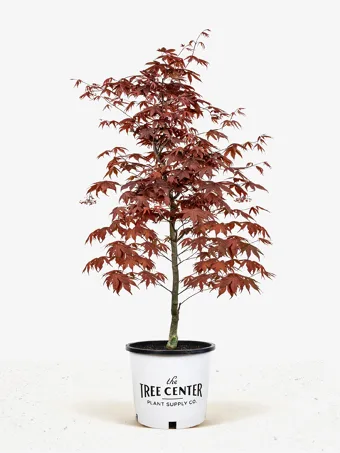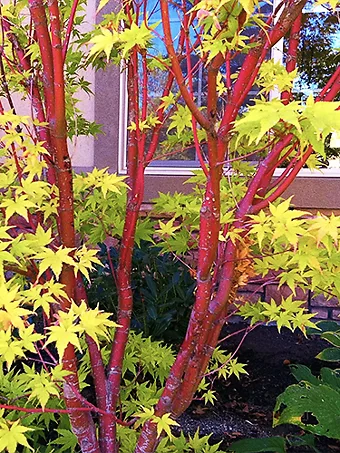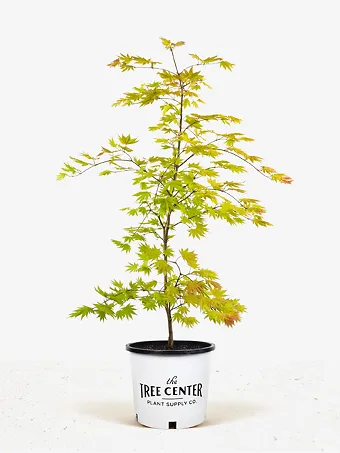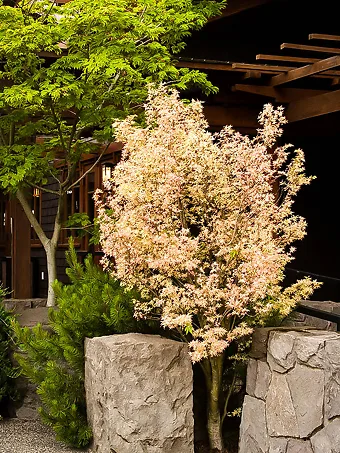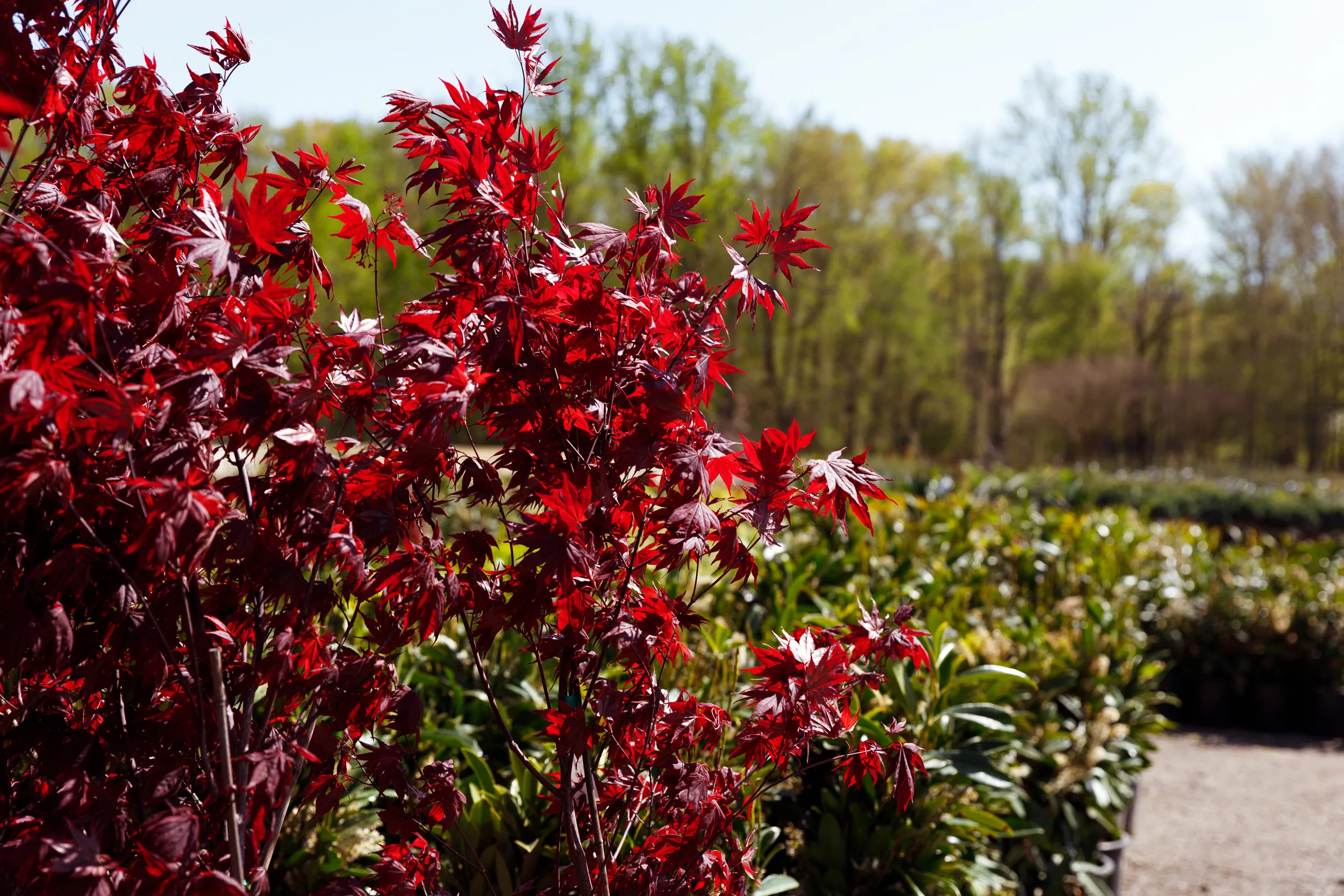
Written by s • Summer Care of Japanese Maple
Everyone loves Japanese maples, with their diversity of leaf color and form. Some are upright, some weeping, while some cascade elegantly over rocks and walls. Leaves may be green, or the coveted rich-reds that are always so popular. Their fall coloring is also varied and spectacular. Some have attractive seed clusters hanging from their bare branches, or brightly-colored twigs glowing in the winter sunlight. A keen gardener could almost build a whole garden around them, the range of varieties is so great and the diversity is so rich.
Keep Japanese Maple Healthy in Summer
- Keep them moist – don’t forget to keep the soil damp, with mulch and regular watering
- Give them afternoon shade – when planting your tree, arrange for afternoon shade in summer
- Choose a suitable variety – some forms resist burning better than others
- Keep them red all summer – plant a newer variety that doesn’t fade to brown
- Use nutrient-rich mulch – this feeds the plant as well as keeping the soil moist
It doesn’t take long for the new gardener to buy their first Japanese maple, since they are so enchanting and appealing. Sadly, some new gardeners are disappointed, finding that their plant does not thrive, and that although they begin the year with glorious spring foliage, as summer arrives the leaves scorch and brown. They then often fall and leave a bare tree just when you want it to be leafy, and of course meaning that those fabulous fall colors are nowhere in sight. With this in mind, let’s lend a hand and give you some tips on how to get your maples through the summer in good health, looking gorgeous and ready for that fall show to come.
Why Does My Japanese Maple Burn in Summer?
There are several interconnected reasons why Japanese maple foliage often dries up and burns in summer. The main reason is lack of moisture. These trees originate in Japan, and there the summer climate is very damp, with high humidity and frequent rain. If you live where summers are dry, the soil and root-ball can dry out, quickly causing the leaves to brown and scorch. As well, these trees grow naturally in the shade of larger trees, so they do not enjoy hot sun, which is most pronounced in the afternoons. Also, some of the varieties with very finely-cut foliage are especially prone to drying, since the leaves are so thin and delicate.
Lack of Water
This is the primary reason for leaves burning. In hot weather, to keep the foliage cool, water evaporates from the underside of the leaves. This must be replaced with water drawn up from the roots. Some garden plants have thick, leathery leaves that only lose a little water by evaporation, so when the soil is dry they are still fine. In contrast, Japanese maple leaves are thin and delicate, so they cannot stop losing water. If that water is not replaced from the roots, the leaves dry out, turn brown, and shrivel up. While this usually doesn’t harm the tree itself much, it certainly makes the tree look bare and it loses much of its appeal too early in the year.
To protect your tree from drying, add plenty of rich organic material to the soil when planting. Dig deeply, and mix that material well into the ground. Digging deeply will allow your tree’s roots to get into the damper soil down below. Add a layer of that organic material over all the roots, to conserve the moisture (and prevent weeds growing too). Water well throughout the spring and summer, letting the water soak down into the ground. A slow trickle for an hour to two is always better than a quick, heavy spraying, which often doesn’t go deep into the soil at all. Don’t rely on rainfall, especially once summer arrives. In a thunderstorm, a lot of the water simply runs off the surface, and bigger trees very quickly suck up any that does go into the ground, so that your Japanese maple may get nothing at all. A long soak once a week – or twice a week during very hot weather, especially if your soil is sandy – will keep up the moisture levels.
Hot Afternoon Sun
Even if you water thoroughly, you might still find that your Japanese maple is scorching, even if only at the tips of the leaves. If this is happening, you might have your tree in the wrong place. While these trees thrive with some direct sunlight, especially in spring, by summer they need protection from the hottest rays between noon and four in the afternoon. When choosing a planting spot – or where to place your tree if it is in a container – find somewhere where there is afternoon shade, but ideally some morning sun. This will keep your tree growing healthily, while keeping the leaves fresh and colorful all summer long.
Growing a more sensitive variety
The size of the leaves of Japanese maples is very variable – this is a large part of their appeal. Those that are often called ‘dissectum’, with deeply divided leaves in thin, narrow lobes, are much more likely to scorch than other varieties with broader leaves. If you don’t have much time for your garden and can’t be sure that sufficient water will be available, or you want to place a plant in a sunny place, then choose a broader leaf form. This is especially important if you live in warmer zones, where it is hard to keep those leaves from scorching. Generally, varieties with broader leaves are much less prone to scorching. The Coral Bark Japanese Maple is often recommended for hotter parts of the country, as with its broader leaves it resists drying well.
Choosing an older red-leaf form
Some of the older types of red-leaf Japanese maples are subject to color-fading, after the glory of their spring display. As summer comes, that brilliant red can turn a less attractive greenish-brown. If you want strong color all summer – and who wouldn’t – then choose a more modern variety like the Purple Ghost Japanese Maple, which can be relied on to hold its color well.
Starving your tree
If your tree is low in nutrients, the leaves will be smaller, so they will be more prone to drying. Keep your tree well fed, by using a rich mulch, and putting down some fresh, new material each fall. Garden compost, or rotted animal manures, like sheep or cow, are much better than bark chips, or shredded bark, which add nothing to the soil. As well, especially when your tree is younger, some feeding with liquid tree food is very beneficial.
Japanese maples are glorious trees, and every garden should have some. If you attend to these simple things, you can enjoy them without the frustration of scorching and burning foliage in summer. It’s easy to get it right.
